The common use for unmanned aerial vehicles (UAVs) in civil life is in the agriculture sector, where they are used to assess how well crops are growing and are utilized to perform meteorological measurements. While there is a substantial demand for drones in other areas as well, two main barriers stand in the way of those who aim to bring the technology to practice – the drones’ relatively large size and lack of maneuverability around obstacles. These drawbacks are especially significant in military operations. Seeing a market opportunity, European researchers and companies have collaborated to form the EU-funded microDrone project, dedicated to developing a smaller, more maneuverable drone. According to AirRobot, one of the major companies participating in the project, the new drone would be capable of carrying out missions autonomously in places with a variety of obstacles. Moreover, emergency situations occurring in urban areas or inside buildings could be dealt with using the new UAV, what will eliminate the need to send human forces into unsafe areas. One of the new drones is the mini-UAV, developed by AirRobot.
The drone is about 50cm in diameter, weighs less than one kilogram and can carry loads of up to 200gr. It looks like a miniature helicopter with four propellers, which allow it to take off and land vertically. A protective band surrounds the machine, preventing it from harming people and its own structure in case of an accident. The company developed both software and hardware of the drone, which allow the AirRobot to locate its position in the air, navigate autonomously, and respond to unexpected events, such as running into obstacles. Other features include mission planning, collision avoidance and trajectory determination. A special feature included is the ‘return home’ function, made available due to the program’s visual memory map that stores information regarding the previous flight path.
There are two manners in which the AirRobot could be sent to its mission. One is a remote control, which allows the user to manually direct the drone. The second is its autonomous system, which provides the option to predefine the UAV’s path. According to AirRobot, the software and interface allow even an operator without any technical knowledge to easily control the device. Project coordinator, Christophe Leroux, said: “The monitoring of public and private sites is becoming increasingly important in the field of security and surveillance; mobile multi-sensor surveillance systems, able to be deployed quickly to analyze a situation, will boost the efficiency of the security teams. By combining sensors and robots, we can develop applications to search and warn, and to detect hazardous materials.” Leroux believes the new drone will be useful for policemen in case of a riot: the measurement of its extent could make the deployment of forces easier.
Another situation in which the drone might come in handy is the investigating of crime scenes inside a building – since it could explore areas without endangering the lives of police officers. Security organizations could find the AirRobot useful as well; for instance, upon the detection of an intrusion, the UAV could be able to move faster than any ground-based robot or a human guard. The consortium is now focusing on evaluating and testing the new drone with potential users, including fire services. A small-sized UAV could be used for reconnaissance of the fire scene, helping fire fighters to better assess how the fire is developing and whether or not there are people trapped inside; but, Leroux says that there are even more uses to the new drone. “Many end-users have already expressed an interest,” he said. The drone was exhibited in Lyon in December 2008 (as seen in this video), and will be tested in collaboration with a fire service in Greece this upcoming November.
TFOT has previously covered the SnowGoose Bravo UAV, capable of launching itself without the need for ground support equipment, and American Dynamics’ AD-150 UAV, a drone designed for both land and sea-based operations. Other related TFOT stories include the development of super quiet UAVs at the Georgia Tech Research Institute (GTRI) in Atlanta, and the development of UAVs designed specifically for remote controlled digital photography and digital video streams. For more information on AirRobot’s UAV, see ICT Results’ website. Source: ICT Results










